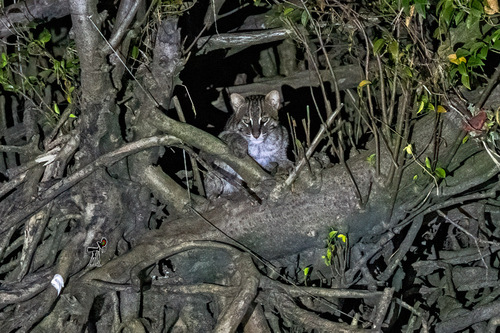
Fishing Cat
The elusive fishing cat, Prionailurus viverrinus, thrives in Asia's marshes. With webbed paws and a penchant for water, it excels at fishing and swimming. This skilled hunter plays a vital role in wetland ecosystems, controlling fish and small mammal populations.
10-12 years
Lifespan
5.5 - 8.0 kg
Weight
Length: 57 - 85 cm
Size
Black, Olive-Grey
Color
9-10 months
Age of Sexual Maturity
4-6 months
Age of Weaning
34 mph
Top Speed
Vulnerable
Conservation Status
Decreasing
Population Trend
Characteristics
Prionailurus viverrinus, commonly known as the fishing cat, is native to South and Southeast Asia's wetlands. It has a stocky build, short legs, and a unique fur pattern with elongated spots and stripes. This nocturnal predator specializes in hunting fish, showcasing remarkable swimming abilities.
Distribution Range of the Fishing Cat
Prionailurus viverrinus, commonly known as the Fishing Cat, is native to South and Southeast Asia. Its geographical distribution includes countries such as India, Nepal, Bangladesh, Sri Lanka, Myanmar, Thailand, Cambodia, Laos, Vietnam, and parts of Indonesia. The species predominantly inhabits the Terai region of the Himalayan foothills, the Brahmaputra and Ganges river basins, and the wetlands of the Sundarbans.
Fishing Cat's Habitat
Environmental Conditions
Fishing Cats inhabit wetland environments, including marshes, swamps, rivers, streams, mangroves, and tidal creeks. They are often found in areas with dense vegetation and water bodies, where they can hunt for fish, their primary prey. The climate in these regions is typically humid and tropical, with significant rainfall. The species is also known to inhabit areas with brackish water and can adapt to seasonal changes in water levels.
Ecological Niche
The Fishing Cat is a semi-aquatic mammal that plays a crucial role in its ecosystem as both a predator and a prey species. Its ecological niche involves hunting a variety of aquatic animals, including fish, frogs, crustaceans, and even small mammals and birds. The species is adapted to swimming and diving, with partially webbed feet that aid in catching prey in water. This adaptation allows it to occupy a unique ecological position compared to other felids, which are primarily terrestrial.
Copyright @ Nature Style Limited. All Rights Reserved.
 English
English